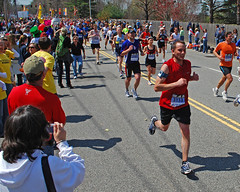If you’ve been running for any length of time, you’ve probably received derisive comments and odd looks from friends/family regarding your running habit. “You’re going to ruin your knees” is a common one, “humans aren’t built to run long distances” is another. Well, I have news for these people – their scornful comments couldn’t be further off-the-mark. Read on, and I’ll attempt to explain why it is that humans are in fact among the premier long-distance runners among all mammals, how we got to where we are atop this podium, and why sitting on the couch is really what is most unnatural for us as a species.
Ever since I started to run in earnest, I’ve had a sense that running is something natural, something that we as humans are supposed to do. To a certain extent, this probably arises from my training as an anatomist/physiologist and evolutionary biologist. If you think about human history, our human body evolved under a very different set of conditions than it is exposed to today. Our bodies did not evolve in an environment where obtaining food simply required a drive to the nearest supermarket or fast-food restaurant. Rather, humans evolved from ape-like ancestors in an environment where food generally had to be either gathered, scavenged, or hunted, and thus physical traits that enhanced the ability to accomplish these food-gathering behaviors were critical to our survival as a species. Of these physical traits, being able to run was likely one of the most important – our ancestors had to be able to catch prey on the run and get to carcasses before they were scavenged by other animals.
Indeed, running is still a tradition in some native cultures, such as among the Tarahumara of northwestern Mexico. The Tarahumara are widely admired for their endurance running capabilities (a Men’s Health article titled “The Men Who Live Forever” details their athletic prowess), and a hunting tradition in the tribe is to chase a wild animal like a deer until it  collapses from exhaustion, at which point it can be caught and killed. This type of hunting, called persistence hunting, is also practiced by some Kalahari bushmen in Africa (you can watch a video clip of a persistence hunt below; see also Liebenberg, 2006), and was described in detail in one of my favorite episodes of NPR’s This American Life. In this episode, Scott Carrier recounts his story of trying to catch a pronghorn antelope by running it down on foot. There was something raw and emotional in Carrier’s story that really struck a chord with me, and if you’re a runner of any kind it’s a great listen (and you can listen to it right now by clicking here). The book “Why We Run: A Natural History,” by Bernd Heinrich (see cover photo above), also describes persistence hunting (as part of the larger story of why he, and we, run), and the new book Born to Run by Christopher McDougall goes into detail on many of the subjects discussed in this post. Both of these are must reads for anyone interested in the science and evolution of running in humans. You can read my review of Born to Run here (which I read after writing this post).
collapses from exhaustion, at which point it can be caught and killed. This type of hunting, called persistence hunting, is also practiced by some Kalahari bushmen in Africa (you can watch a video clip of a persistence hunt below; see also Liebenberg, 2006), and was described in detail in one of my favorite episodes of NPR’s This American Life. In this episode, Scott Carrier recounts his story of trying to catch a pronghorn antelope by running it down on foot. There was something raw and emotional in Carrier’s story that really struck a chord with me, and if you’re a runner of any kind it’s a great listen (and you can listen to it right now by clicking here). The book “Why We Run: A Natural History,” by Bernd Heinrich (see cover photo above), also describes persistence hunting (as part of the larger story of why he, and we, run), and the new book Born to Run by Christopher McDougall goes into detail on many of the subjects discussed in this post. Both of these are must reads for anyone interested in the science and evolution of running in humans. You can read my review of Born to Run here (which I read after writing this post).
Before I explain the evolutionary hypotheses in more detail, let me start by pointing out that we as humans are darned good endurance runners. In fact, we may just be the best among all mammals when it comes to endurance running. What we lack in speed, we more than make up for in our ability to run long distances at a slow, sustained pace. For this reason, we are one of the few species on earth that can actually complete a marathon. Take dogs for example – I frequently run with my black lab Jack. In a flat out sprint, Jack would blow me away (he spotted a deer behind our house this afternoon, and his sprint through the woods was a thing to behold). However, when I’m marathon training, I’m careful not to take him much more than 6-7 miles since he burns out after about that distance. Even in winter, there are times when we return from a run and he has to roll around in the snow just to cool down. Keep in mind, dogs are pretty good endurance runners as animals go, but we humans blow them away when it comes to running long distance (an possible exception might be the wolf). As another example, most people would hold horses up as a prime
example of an animal designed to go the distance. However, during the annual Man versus Horse Marathon in Wales, humans have defeated the fastest horse in the race on at least two recent occasions (see BBC News story), demonstrating that when it comes to endurance among mammals, we are right there at the top. Indeed, in a 2007 paper in the journal Sports Medicine titled “The Evolution of Marathon Running,” authors Daniel Lieberman (Harvard) and Dennis Bramble (University of Utah) report that “for marathon-length distances, humans can outrun almost all other mammals and can sometimes outrun even horses, especially when it is hot.”
So lets look at the the data supporting the hypothesis that humans evolved to be runners in a bit more detail. The logic according to Lieberman and Bramble (2007) goes something like this:
1. Our primate ancestors are not good runners. The reason for this is that their anatomy is more suited to life in the trees, and whereas chimps can sprint, they cannot do so for much more than 100m.
2. Fossil evidence shows that about 2 million years ago, our already bipedal ancestors began to exhibit anatomical traits that make for more efficient running (see list below, also see a Nature article by Bramble and Lieberman, 2004).
3. These anatomical changes appeared in association with the invasion of a new habitat and the appearance of new food-gathering tactics (i.e., a new niche in ecological parlance). Human ancestors were moving from the trees onto the ground, and we were becoming daytime hunters, with a penchant for eating meat. Fossil evidence (e.g., tooth characteristics) suggests that human ancestors began incorporating meat to a larger degree about 2.5 million years ago (this is not to say that chimps don’t eat some meat – they do). In order to get meat into the diet, we had to hunt and scavenge (and keep in mind that our earliest ancestors didn’t have stone-tipped spears, bows, or high-powered rifles and shotguns). Lieberman and Bramble (2007) cite a 2006 paper by John J. Shea from the Journal of Archaeological Science that indicates that stone-tipped spears didn’t appear until about 200,000 years ago, whereas bows have been around for only about the last 50,000 years. Thus, to kill an animal, we had to do it at close range, which means either ambushing them (which can be dangerous to the hunter) or chasing them down. We also had to compete with other carnivores and scavengers (think lions and hyenas) for limited resources in a hot, arid environment. This placed high emphasis on speed and endurance, as well as efficient heat regulation. End result = we as humans evolved to be outstanding runners, and what’s more, we can run efficiently for long distances in environmental conditions that would rapidly exhaust or could potentially even kill most other mammals.
So what is it about humans that makes us such good distance runners? What are the traits that separate us from our nearest relatives? Bramble and Lieberman (2004) and Lieberman and Bramble (2007) suggest the following:
1. Energetics – Humans have springy ligaments in the legs and feet (e.g., the Achilles tendon, the longitudinal arch of the foot, and the iliotibial tract are examples) that allow us to store energy during each footstrike and then release that energy like a spring on toe-off. Conversely, in African apes these tendons/ligaments are more poorly-developed or absent.
2. Stabilization – It is harder to stabilize the body while running than it is to do so while walking, especially in bipeds. Humans have unique anatomical characteristics that confer much greater stability while running. Among other things, these traits include a well-developed gluteus maximus that is mostly active while running (yes, big butts!), a narrow waist, mobile torso, and improvements in the inner ear that help us to better maintain balance.
3. Thermoregulation – As any runner knows, physical exertion generates body-heat. Because running is muscle-intensive, it generates much more heat than walking, and if we don’t get rid of that heat we can get into trouble (i.e., hyperthermia). One of the reasons why many mammals can’t go the distance is that they don’t have specializations to offload all of the heat produced while running. This is why my dog, Jack, can’t join me for a 20-mile marathon training run in the spring or summer. Humans, on the other hand, can run long in the heat (like on the African plains, or in the Badwater 135 Ultramarathon) because we are expert sweaters. We have no fur (well, most of us) to heat us up, and our sweat glands are densely and widely dispersed across the surface of our bodies. When we run, we sweat, often profusely. When we sweat, we cool down. We retain hair on places like our scalp to keep the brain warm and prevent skin cancer since the scalp is the portion of our body exposed to direct sunlight when we’re outside. The tradeoff here is that we humans lose a lot of salt and fluid when we’re active, which is why companies like Gatorade stay in business.
To summarize the logic of what’s above, I offer the following: We humans evolved to be hunters. To hunt without bows and guns we needed to run. In order to become more efficient hunters, we evolved anatomical and physiological traits that made us better runners. Now that hunting is no longer a necessity, our species for the most part has stopped running, but that absolutely does not mean that running is unnatural or dangerous. Rather, I would argue (strongly) that running is completely natural for humans, and that not running is in fact what is aberrant. Think about it for a minute or two and see if you agree.
Let me finish with a few thoughts. First – the next time someone tells you that running is unnatural, refer them to this post or to the work of the scientists cited here. Simply stated, we as humans evolved to run, and there is nothing more natural that we could do. Does this mean that running marathons every day is natural? Probably not. Does it mean that running a race like the Badwater 135 Ultramarathon is natural? Probably not. Does it mean that every modern human has a body suited to distance running? Probably not. What it does mean is that the next time you lace up your shoes for a run, you are simply celebrating our evolutionary history as a species, and doing something that we have been doing effectively for millions of years. In short, you are being a good animal, a good human. To look at this in one last way, I’ll quote the final paragraph of Lieberman and Bramble’s excellent 2007 article:
“In short, the human ability to run long distances, such as a marathon, is neither a simple byproduct of the ability to walk bipedally, nor a biologically aberrant behaviour. Instead, running has deep evolutionary roots. Although humans no longer need to run, the capacity and proclivity to run marathons is the modern manifestation of a uniquely human trait that helps make humans the way we are.“
How’s that for motivation.
Happy running!
Update 1/22/2010: I’ve now recorded a podcast on the topic of the evolution of distance running in humans. You can check it out here: Runblogger Runcast #7: The Evolution of Distance Running in Humans.
If you agree that humans evolved to run, please spread the word:
Literature Cited:
In addition to the articles below, you can also follow this link to another post that provides a much longer list of popular articles, scholarly articles, and blog posts on the evolution of running in humans.
Bramble DM, Lieberman DE. 2004. Endurance running and the Evolution of Homo. Nature 432:345-352.
If you liked this post and want to learn more about why humans run so well and how we evolved to do so, I highly recommend the following books by Bernd Heinrich and Christopher McDougall:



![Reblog this post [with Zemanta]](https://img.zemanta.com/reblog_e.png?x-id=8d3b49f7-15e8-4993-aa14-e6320db13af8)

















Makes sense to me, and explains why so many of are driven to running and find so much pleasure and stress-relief from it.
I’m skeptical about the conclusion you draw about dogs. I’ve hiked with a a friend’s otherwise-sedentary golden retriever and he basically covered three times the ground I did, running up the mountain and then back down to make sure I was still coming, again and again. I’m in very good shape, but there was little doubt that this dog could outlast me with even moderate regular exercise. This was in cool fall temperatures.
I also remember reading about a woman who trained for marathons with a few Rhodesian Ridgebacks. I believe she was doing upper-teens mileage with significant elevation gains. She said her dogs showed no signs of fatigue and she was sure they could go much further than her.
These are anecdotal events, but then so is the opposing evidence you cited, namely your Lab’s inability to shed heat.
But thanks for your efforts, i’m finding the blog very useful.
The point is heat. My lab could do the same thing on a cool Fall day
like the one you describe, but never in the heat of summer under
direct sun. The latter is the environment our ancestors took advantage
of to persistence hunt. Jack can run forever with me in winter, but
even taking him on a long walk on a humid, 90 degree day is dangerous.
Pete
Right. In any case thermoregulation would seem to be very breed-specific. Ridgebacks are African hunting dogs of course, and one of the articles you linked to specifically mentions those dogs as possessing exceptional ER capabilities. So we have to be careful when we make blanket statements about ‘dogs’. What would kill a Lab or a Husky might be a warm-up for a Basenji.
Also keep in mind though that dogs that do well in heat have been
artificially selected via breeding to express that capability. It was not
present in the ancestral wolf from which domestic dog breeds have come. In a
similar manner, humans evolved from our primate ancestors through natural
selection to be very good at operating in the heat. The critical point is
that we can do things in the heat that the vast majority of quadrupedal
mammals cannot.
The first article had a few rather eye-opening points, but yeah the fact the we are far on the right of the bell-curve as endurance athletes in the heat is not what conventional wisdom would predict.
It’s an exciting narrative that’s unfolding. Understanding our evolutionary heritage is such a key facet of understanding ourselves. For me at least, that intellectual understanding always expands and clarifies my sense of where I stand in the world on an -ahem- existential level.
From my recent paper in Human Evolution 28:237-266: “The nowadays popular ideas about Pleistocene human ancestors running in open plains (endurance running, dogged pursuit of swifter animals, born to run, le singe coureur, Savannahstan) are among the worst scientific hypotheses ever proposed. The surprising frequency and diversity of foot problems (e.g., hammertoes, hallux valgus and bunions, ingrown nails, heelspurs, athlete’s feet, corns and calluses—some of these due to wearing shoes) and the need to protect our feet with shoes prove that human feet are not made in the first place for running. Moreover, humans are physiologically ill-adapted to dry open milieus: ‘We have a water- and sodium-wasting cooling system of abundant sweat glands, totally unfit for a dry environment. Our maximal urine concentration is much too low for a savanna-dwelling mammal. We need much more water than other primates, and have to drink more often than savanna inhabitants, yet we cannot drink large quantities at a time (Verhaegen 1987 Origin of Hominid Bipedalism, Nature 325:305-6).”
Incredible that are still ‘scientsts’ who believe this Pleistocene Homo running fantasy, just google ‘econiche Homo’.
Human Evolution now publishes the proceedings of the symposium on human waterside evolution ‘Human Evolution: Past, Present & Future’ in London 8-10 May 2013:
SPECIAL EDITION PART 1 (end 2013)
Introduction – Peter Rhys-Evans
1. Human’s Association with Water Bodies: the ‘Exaggerated Diving Reflex’ and its Relationship with the Evolutionary Allometry of Human Pelvic and Brain Sizes – Stephen Oppenheimer
2. Human Ecological Breadth: Why Neither Savanna nor Aquatic Hypotheses can Hold Water – JH Langdon
3. Endurance Running versus Underwater Foraging: an Anatomical and Palaeoecological Perspective – Stephen Munro
4. Wading Hypotheses of the Origin of Human Bipedalism – Algis Kuliukas
5. The Aquatic Ape Evolves: Common Misconceptions and Unproven Assumptions about the So-Called Aquatic Ape Hypothesis – Marc Verhaegen
6. The Epigenetic Emergence of Culture at the Coastline: Interaction of Genes, Nutrition, Environment and Demography – CL Broadhurst & Michael Crawford
SPECIAL EDITION PART 2 (begin 2014) with 12 contributions
A very limited perspective of the “problems” with running. It only takes a little time being exposed to cultures that don’t normally use footwear to see that the problems you highlight are associated with footwear, not evolution. As for running in the heat, runners conditioned to it can cope quite well.